Abstract
This article deals with a class of nonlinear fractional differential equations, with initial conditions, involving the Riemann–Liouville fractional derivative of order . The main objectives are to obtain conditions for the existence and uniqueness of solutions (within appropriate spaces), and to analyze the stabilities of Ulam–Hyers and Ulam–Hyers–Rassias types. In fact, different conditions for the existence and uniqueness of solutions are obtained based on the analysis of an associated class of fractional integral equations and distinct fixed-point arguments. Additionally, using a Bielecki-type metric and some additional contractive arguments, conditions are also obtained to guarantee Ulam–Hyers and Ulam–Hyers–Rassias stabilities for the problems under analysis. Examples are also included to illustrate the theory.
Keywords:
fractional differential equations; Riemann–Liouville derivative; fixed point theory; Ulam–Hyers stability; Ulam–Hyers–Rassias stability MSC:
34A08; 26A33; 34A12; 34B15; 34D20; 45M10; 47H10
1. Introduction
Given the importance that fractional derivatives and integrals [,,,,,,] have shown to have in the optimization and improvement of mathematical models of real events or even of those associated with other areas of knowledge (namely through making these models more accurate when compared to what they effectively model), we have recently witnessed a large development in the mathematical analysis of classes of fractional order differential and integral equations.
In this context, it is essential to know about the possible existence of several solutions to the problems in question, possible sufficient conditions to obtain a unique solution and even conditions that eventually guarantee distinct forms of stability of the solutions (this being a crucial aspect, in particular, for the study of approximate solutions to the problems in analysis). The most used techniques in these problems involve the consideration and identification of operators that (in a sense) represent the problem (in some “equivalent” way) and usually involve different principles of contraction, as well as different estimates, usually framed, or dependent, on norms (or metrics), within the spaces framework most suited to the problems under study.
For this type of problem, the analysis of their eventual stability is also a study of significant importance. Namely, through the Ulam–Hyers and Ulam–Hyers–Rassias stabilities [,,,,,,,,,,] which, with their specific characteristics, make it possible to identify forms of a slight disturbance in the system (that defines the problem) does not have a too disturbing effect on that system.
Having this general framework in mind, we would like to start by emphasizing that in [], Chai studied the existence of solutions to the boundary value problem
where and denote the standard Caputo derivatives of order and , respectively, in this case with , and . Additionally, more recently, Xu et al. [] considered the existence of solutions and the Ulam–Hyers stability for the fractional boundary value problem
where denotes the Riemann–Liouville fractional derivative operator of order , , , , , , , denotes the Riemann–Liouville fractional integral operator of order , and . Moreover, in [], Ahmad et al. investigated the existence of solutions and the Ulam–Hyers stability for a fractional initial value problem given by
where is again the Caputo fractional derivative of order , and and are nonzero constants. In [], Alvan et al. investigated the existence of solutions for the fractional boundary value problem
where and is a positive real number. Bilgici and Şan [] considered the existence and uniqueness of solutions to the problem
where and .
Motivated by the analysis and the results already achieved for the above-mentioned problems (included in the works [,,,,]), we investigate in this paper the stabilities of Ulam–Hyers and Ulam–Hyers–Rassias types [,,,,,,], and the existence and uniqueness of solutions to the following initial value problem of fractional order (IVPFO)
where , is a nonzero constant, (with ) and is a continuous function. Thus, this problem can also be viewed as a class of problems depending on the parameter , and with the form of a single-point boundary problem “a” of a two-term fractional differential equation.
The remaining part of the work is organized as follows: Section 2 contains the necessary definitions and the fundamental tools that are used in the sections that follow; in Section 3, we derive different conditions for the existence and uniqueness of solutions for the IVPFO (1); in Section 4, we discuss the Ulam–Hyers and the Ulam–Hyers–Rassias stabilities and obtain conditions for their existence. Finally, some examples are included to describe the obtained results in a more concrete way.
2. Preliminaries and Background Material
We start this section by presenting the known basic definitions of the main objects that we will use.
Definition 1.
The Riemann–Liouville fractional integral of order of a function x (on ) is defined by
provided the right-hand side is pointwise defined and where
denotes the Euler Gamma function (given by ).
Definition 2.
The Riemann–Liouville fractional derivative of order of a function x (on ) is defined by
with .
In what follows, we denote by the Banach space of Lebesgue integrable functions from into with the norm and by the Banach space of all continuous functions endowed with the norm .
Lemma 1
([]). Assume that with a fractional derivative of order . Then
and
for some , , where n is the smallest integer greater than or equal to α.
For the reader’s convenience, let us recall some classic principles of contraction and inequalities that we will use later.
Theorem 1
(Banach contraction principle). Let be a generalized complete metric space, and consider a mapping which is a strictly contractive operator, that is
for some constant . Then:
- (a)
- the mapping T has a unique fixed point ;
- (b)
- the fixed point is globally attractive, namely, for any starting point , the following identity holds:
- (c)
- we have the following inequalities:
Theorem 2
(Schauder’s fixed point theorem). If is a closed, bounded, convex subset of a Banach space X and the mapping is completely continuous, then T has a fixed point in .
Keeping in mind some parts of the proofs of the next results, let us recall an important integral inequality that we will actually use later.
Theorem 3
([], [Theorem 11.2]). Let and be nonnegative continuous functions for and suppose that
for , where are constants. Then,
where .
We denote by the space of functions x which are 2-times continuously differentiable on endowed with the norm
It is well-known that is a Banach space.
In our next analysis of the existence and uniqueness of solutions for the IVPFO (1), we will make use of the following auxiliary property (which may be considered as a very natural and expectable property; cf., e.g., []).
Lemma 2
(See also []). Let and with . Then and
Moreover,
Proof.
For the reader’s convenience, we have chosen to include here a proof of this lemma. Within the stated conditions, we simply have to use integration by parts to obtain
And so, it follows
Since under the present conditions is continuous on , we conclude that is continuous on .
Moreover,
Integrating by parts, and using the circumstance that , we obtain
which concludes the proof. □
Remark 1.
Proceeding in a similar way as in the previous lemma, for , and , it follows that and
3. Different Conditions for the Existence and Uniqueness of Solutions
In the present section, we will analyse conditions to ensure the existence of solutions to the IVPFO (1) and also conditions to guarantee the uniqueness of the solution. In view of this, let us first start to “translate” the IVPFO (1) through a fractional integral equation.
Proposition 1.
As before, let , be a continuous function and . A function is a solution of the IVPFO (1) if and only if x satisfies the integral equation
Proof.
Let be the solution of IVPFO (1). By Lemma 2, we have that and . Thus, we can rewrite our main equation in (1),
in the form
In view of Lemma 1, one has
Thus, applying to both members of Equation (4), we obtain
Since , we conclude that
and so it follows
Let . One has that
Substituting the last two identities in (6), we obtain
Since , we have that . Moreover, is a continuously differentiable function. Thus, integrating Equation (7) from a to t, we obtain
Taking into account that , it follows that
and using the initial conditions, we conclude that
Conversely, assume that x is given by (3), and thus
It is clear that and since x is continuously differentiable on , differentiating both sides of (8), we get
which is equivalent to
Thus and since , accordingly to Lemma 2, we have that and exist. Applying to both sides of Equation (9), using Lemma 1 and (2), we also obtain
which completes the proof. □
Having in mind Proposition 1, we realize that studying the solutions of IVPFO (1) is the same as studying the solutions of
where T is the fractional integral operator given by
for and .
Remark 2.
Another way to discover an integral form of is to consider the integral equation
In fact, applying to both members of equation , and using Lemma 1, we obtain
(), which is equivalent to
Since , it follows that . Observing that
and using the initial condition , we also conclude that , and thus, Equation (11) is obtained.
Let us fix the following notation
and
Theorem 4.
Proof.
We will use the Schauder fixed point theorem for the fractional integral operator T, defined in (10). The continuity of follows from the continuity of f. Moreover, we have that
and
Since f is continuously differentiable, there exist positive constants A and B such that and , . Define with R being a positive real number satisfying
It is clear that is a closed, bounded and convex subset of . Moreover, we have that
and
Thus, we have that
Thus, if , we have that
and if , we have
Consequently, we conclude that T is a bounded operator on .
Let us prove that operator is completely continuous. For , , one has
which tends to zero as (independently of x and ). In the same way, we get
which tends to zero as . Finally, we observe that
tends to zero as . Thus, we conclude that is equicontinuous. Following Arzelà-Ascoli Theorem, we obtain that T is completely continuous. Applying Schauder’s fixed point theorem (cf. Theorem 2), we conclude that the operator T has at least one fixed point, which means that the IVPFO (1) has at least one solution and the proof is completed. □
We will now exhibit other conditions under which, besides the existence of solutions, we will also guarantee the uniqueness of the solution to the IVPFO (1).
Theorem 5.
Let be a continuously differentiable function and suppose that there are and such that, for ,
If
then the problem (1) has a unique solution on .
Proof.
Since f is a continuously differentiable function, according to Theorem 4, the IVPFO (1) admits at least one solution. Let us assume that conditions (13)–(14) hold. Thus, we can obtain that, for ,
and
Thus, we conclude that, for
and for ,
Since , we have that T is a contractive operator. Thus, by Banach contraction principle (cf. Theorem 1), we conclude that T has a unique fixed point, which from Proposition 1 means that the IVPFO (1) has a unique solution on . □
4. Ulam–Hyers and Ulam–Hyers–Rassias Stabilities
In this section, we analyse the Ulam–Hyers and the Ulam–Hyers–Rassias stabilities of the above class of problems. In fact, since from Proposition 1 we have a new Equation (3) to describe the IVPFO (1) equivalently, we may choose to discuss the stabilities of (1) or (3). Thus, in here, we choose to exhibit, in detail, conditions for the Ulam–Hyers stability of (1) and the Ulam–Hyers–Rassias stability of (3). To this purpose, let us first point out what are the definitions of such stabilities in each of those cases.
Definition 3.
Remark 3.
If we look at what is inside the modulus function in (15) as a single “new” function h, it directly follows that a function is a solution of the inequality in (15) if and only if there exists a function (which depends on y) such that
- (i)
- , ,
- (ii)
- ,
- (iii)
- , .
Definition 4.
4.1. Ulam–Hyers Stability
As indicated above, we will start by identifying conditions that guarantee the Ulam–Hyers of the IVPFO (1).
Theorem 6.
Let the continuously differentiable function f satisfy the Lipschitz conditions (13)–(14), for all , and assume that
If satisfies the inequality and initial conditions (15) (with ), for all , then there exists a unique solution of the IVPFO (1) such that
for
which, in particular, means that the IVPFO (1) is Ulam–Hyers stable.
Proof.
According to the hypothesis, there exists a unique solution of the IVPFO (1).
4.2. Ulam–Hyers–Rassias Stability
We will now consider the Ulam–Hyers–Rassias stability. For that purpose, we consider the space equipped with the Bielecki type metric
where is a non-decreasing continuous function . It is known that is a complete metric space (cf. []).
Theorem 7.
Let be a continuous function satisfying the Lipschitz condition
with . Additionally, let be a nondecreasing function and suppose that exist a constant such that
If y satisfies
and , then there exist a solution x of the fractional integral Equation (3) such that
i.e., under the present conditions, the fractional integral Equation (3) has the Ulam–Hyers– Rassias stability.
Proof.
Having in mind the fractional integral Equation (3), we will consider (in the framework of the above presented Bielecki type metric) the operator defined by
Let us first prove that T is strictly contractive in . For any , we have
Consequently, for , we have that T is strictly contractive in the present framework, and we have a unique solution x to the equation .
Let us now identify as an upper bound for , and use this knowledge. Indeed, from the hypothesis, we have
which allows us to conclude that
and so
□
The Ulam–Hyers stability is a particular case of the Ulam–Hyers–Rassias stability in the sense that instead of having a function controlling the differences in the last stability, we simply have a constant k in the first one. Thus, attending that
and proceeding in an identical way to the proof of Theorem 7, we would pass from an upper bound that depends on a function (of the variable t) to an upper bound in the form of a constant, which is here directly concluded (following the proof of Theorem 7) in the next result:
Corollary 1.
Let be a continuous function satisfying the Lipschitz condition
with . Let
Remark 4.
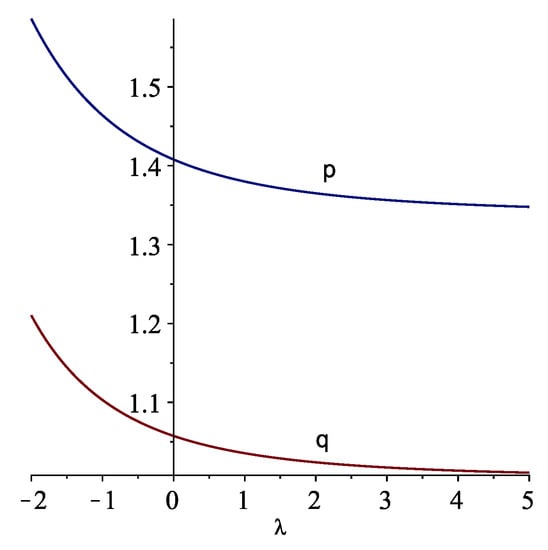
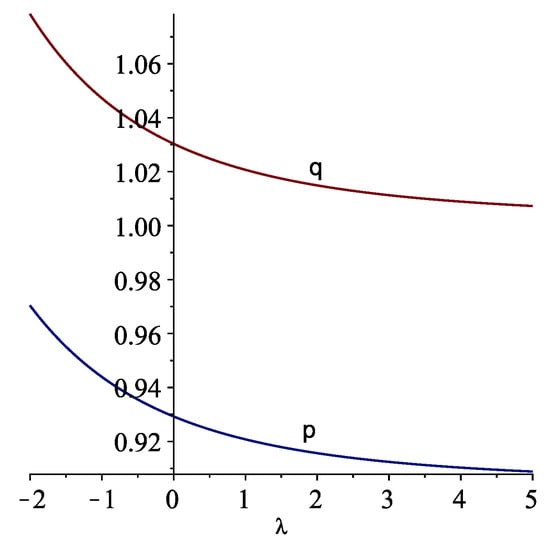
Please, note that the constants k in (18) and in (20) cannot be compared for all the values of the parameters. Consider, for example, the following cases. Admit that , and consider two intervals, one of amplitude equal 1 and another one with amplitude . With these values, we have that, for condition (17) is verified and also, for η as defined in (19). For the case , it is possible to observe that (cf. Figure 1, where ). For the case , we verify that (cf. Figure 2, where ).

Figure 1.
The graphs of and for : case .

Figure 2.
The graphs of and for : case .
4.3. Concrete Examples
Let us now consider some concrete examples to illustrate the above theory.
We start by considering the following IVPFO
for . Thus, in the previous notation, we have in here , , and
being clear that f is a continuously differentiable function.
According to Theorem 4, there exists, at least, one solution of the IVPFO (21). In addition, having in mind that , for , one has that
Following Theorem 5 and its notation, we have in here . Thus, for and , we obtain that
for (cf. (12) and Figure 3). Thus, for these cases of , the IVPFO (21) admits a unique solution in . Moreover, from Theorem 6, we also know that for those the IVPFO (21) is Ulam–Hyers stable.
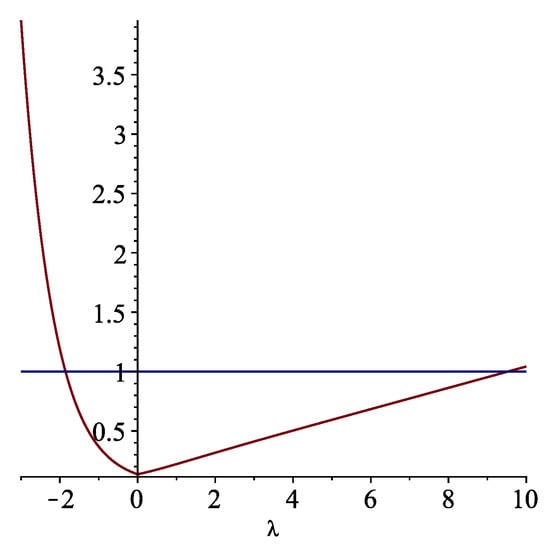
Figure 3.
The graphs of and .
The example we have just analyzed allows us to see that there really are classes of problems, dependent on , in which the conditions required in Theorem 5 are met, and there are still other cases (for different parameters ) in which this is not the case. In view of this, and keeping in mind that the conditions of Theorem 5 are just sufficient conditions, an open analysis eventually involves obtaining other weaker conditions according to which the uniqueness of solution for those classes of problems can still be guaranteed. The same can be envisaged for Theorem 6 and its sufficient conditions to guarantee the stability of the Ulam–Hyers type.
Let us now investigate the Ulam–Hyers–Rassias stability of
for and .
Letting , we have that is a non-decreasing function and
(cf. Figure 4). Thus, for the notation of Theorem 7, we have , and so .

Figure 4.
The graphs of (the upper one), and .
Take . We have that and . We have that (cf. Figure 5)
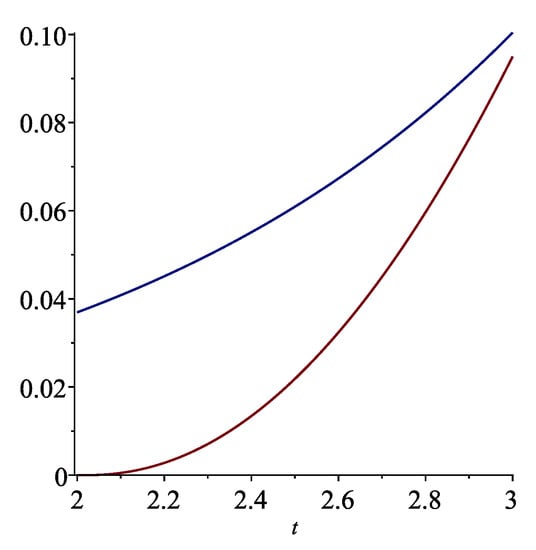
Figure 5.
The graphs of (the upper one) and , .
Thus, according to Theorem 7, the problem (22) is Ulam–Hyers–Rassias stable with respect to and
Moreover, we can also observe that
Thus, applying Corollary 1 and the respective notation, we have that . Additionally, and we conclude that
In this last example, it is relevant to emphasize the importance of the function in the whole process, with special predominance, from the outset, in the determination of the exhibited upper bounds. In this case, we chose to work with the exponential function, and this had expected consequences given the growth that the function presents. Incidentally, the importance of the choice and the impact that the function has is well evidenced by the fact that the same problem can be Ulam–Hyers–Rassias stable for a given function and not Ulam–Hyers–Rassias stable for another function. Thus, it is precisely for this reason that the Ulam–Hyers–Rassias stability is determined depending on the chosen function (and it is also for this reason that this is explicitly mentioned in the name of this type of stability).
Let us now consider the following different IVPFO
Accordingly to the previous notations, we have now , , and . It is clear that f is a continuously differentiable function in . Thus there exists, at least, one solution of the IVPFO (23) (cf. Theorem 4). Moreover, one has that
Following Theorem 5, we have . Since and , we obtain that for , the condition
is verified (cf. Figure 6), which means that the IVPFO (23) admits a unique solution in when considering those values of (cf. Theorem 5).
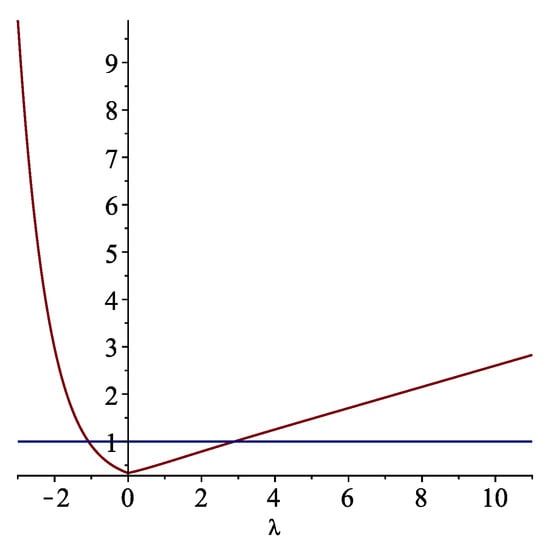
Figure 6.
The graphs of and .
Thus, for these cases of , the IVPFO (23) admits a unique solution in . Moreover, from Theorem 6, we also know that for those the IVPFO (23) is Ulam–Hyers stable.
Let us now analyse the Ulam–Hyers–Rassias stability of
for , , and with respect to . Let be the exact solution of the IVPFO (23), and let us consider . It follows that and . We have that is a nondecreasing function and
(cf. Figure 7).
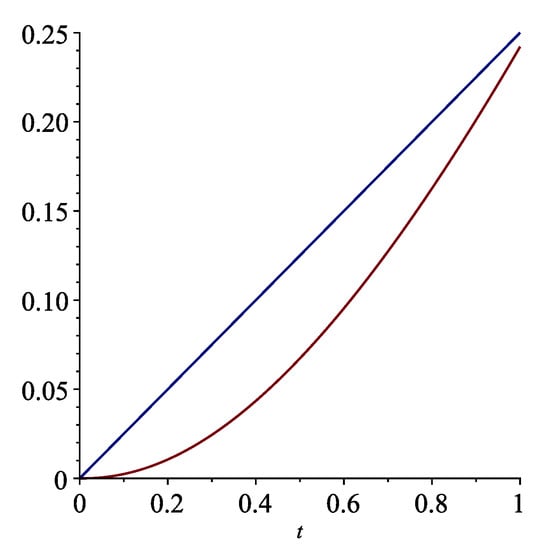
Figure 7.
The graphs of and .
For the notation of Theorem 7, we have and , and so . Thus,
(cf. Figure 8).
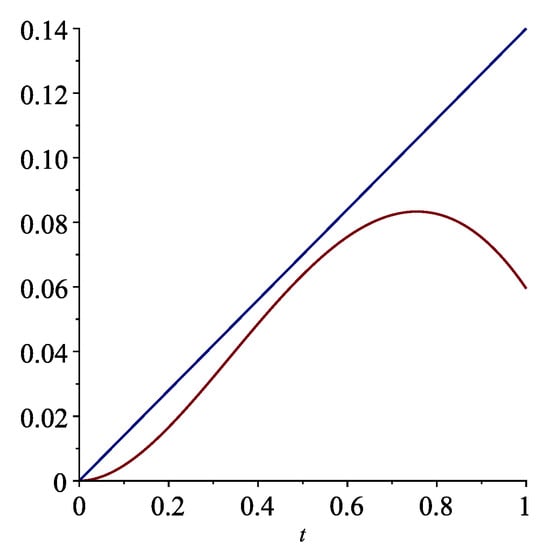
Figure 8.
The graphs of (the lower one) and .
Therefore, according to Theorem 7, the problem (24) is Ulam–Hyers–Rassias stable with respect to and
In this last example, we deliberately chose to work with , which can be considered not the most ideal choice (which, by the way, can be easily noticed when we look at Figure 8 and see, on the right, the “greatest” distance between the two functions represented there). Anyway, we consider this example important because it emphasizes that the theoretical conditions obtained earlier are robust enough to guarantee stability in less favorable or obvious choices.
Moreover, according to Corollary 1, we can also conclude the Ulam–Hyers stability. Using the respective notation of the Corollary, we have that , and . Thus, we conclude that
5. Conclusions
We conclude this article by summarizing the results obtained. We analyze a class of nonlinear fractional differential equations, with initial conditions, characterized by having the Riemann–Liouville fractional derivative of order . Having made use of distinct fixed-point arguments, we were able to deduce conditions that guarantee the existence and uniqueness of solutions in a frame of adequate spaces, and we also obtained sufficient conditions to have the Ulam–Hyers and Ulam–Hyers–Rassias stabilities of the problems in the analysis (where the use of a Bielecki-type metric and some additional contractive arguments were of crucial importance). In the last section, some examples were included mainly to illustrate that the conditions obtained in the theoretical part really exist and can be considered in particular cases.
Author Contributions
Conceptualization, L.P.C. and A.S.S.; methodology, L.P.C. and A.S.S.; formal analysis, L.P.C. and A.S.S.; investigation, L.P.C. and A.S.S.; writing—original draft preparation, L.P.C. and A.S.S.; writing—review and editing, L.P.C. and A.S.S. All authors have read and agreed to the published version of the manuscript.
Funding
This work is supported by the Center for Research and Development in Mathematics and Applications (CIDMA) through the Portuguese Foundation for Science and Technology (FCT—Fundação para a Ciência e a Tecnologia), reference UIDB/04106/2020. Additionally, A. Silva is also funded by national funds (OE), through FCT, I.P., in the scope of the framework contract foreseen in the numbers 4, 5, and 6 of article 23, of the Decree-Law 57/2016, of 29 August, changed by Law 57/2017, of 19 July.
Data Availability Statement
Not applicable.
Acknowledgments
The authors would like to thank the Referees for their work in reviewing the present investigation and for providing their observations and suggestions.
Conflicts of Interest
The authors declare no conflict of interest. The funders had no role in the design of the study; in the collection, analyses, or interpretation of data; in the writing of the manuscript, or in the decision to publish the results.
References
- Castro, L.P.; Silva, A.S. On the solution and Ulam-Hyers-Rassias stability of a Caputo fractional boundary value problem. Math. Biosci. Eng. 2022, 19, 10809–10825. [Google Scholar] [CrossRef] [PubMed]
- Fahad, H.M.; Fernandez, A.; Ur, R.M.; Siddiqi, M. Tempered and Hadamard-type fractional calculus with respect to functions. Mediterr. J. Math. 2021, 18, 143. [Google Scholar] [CrossRef]
- Kilbas, A.A.; Srivastava, H.M.; Trujillo, J.J. Theory and Applications of Fractional Differential Equations; Elsevier: Amsterdam, The Netherlands, 2016. [Google Scholar]
- Mali, A.D.; Kucche, K.D.; Fernandez, A.; Fahad, H.M. On tempered fractional calculus with respect to functions and the associated fractional differential equations. Math. Methods Appl. Sci. 2022, 45, 11134–11157. [Google Scholar] [CrossRef]
- Miller, K.; Ross, B. An Introduction to the Fractional Calculus and Fractional Differential Equations; Wiley: New York, NY, USA, 1993. [Google Scholar]
- Podlubny, I. Fractional Differential Equations; Academic Press: San Diego, CA, USA, 1999. [Google Scholar]
- Samko, S.G.; Kilbas, A.A.; Marichev, O.I. Fractional Integrals and Derivatives. Theory and Applications; Translated from the 1987 Russian Original; Gordon and Breach Science Publishers: Yverdon, Switzerland, 1993. [Google Scholar]
- Aoki, T. On the stability of the linear transformation in Banach spaces. J. Math. Soc. Jpn. 1950, 2, 64–66. [Google Scholar] [CrossRef]
- Castro, L.P.; Simões, A.M. Hyers-Ulam-Rassias stability of nonlinear integral equations through the Bielecki metric. Math. Methods Appl. Sci. 2018, 41, 7367–7383. [Google Scholar] [CrossRef]
- Castro, L.P.; Simões, A.M. Different types of Hyers-Ulam-Rassias stabilities for a class of integro-differential equations. Filomat 2017, 31, 5379–5390. [Google Scholar] [CrossRef]
- Hyers, D.H. On the stability of the linear functional equation. Proc. Natl. Acad. Sci. USA 1941, 27, 222–224. [Google Scholar] [CrossRef] [PubMed]
- Marian, D. Semi-Hyers–Ulam–Rassias stability of the convection partial differential equation via Laplace transform. Mathematics 2021, 9, 2980. [Google Scholar] [CrossRef]
- Marian, D.; Ciplea, S.A.; Lungu, N. Hyers–Ulam stability of a system of hyperbolic partial differential equations. Mathematics 2022, 10, 2183. [Google Scholar] [CrossRef]
- Rassias, T.M. On the stability of the linear mapping in Banach spaces. Proc. Am. Math. Soc. 1978, 72, 297–300. [Google Scholar] [CrossRef]
- Sousa, J.V.d.C.; Oliveira, D.S.; Capelas de Oliveira, E. A note on the mild solutions of Hilfer impulsive fractional differential equations. Chaos Solitons Fractals 2021, 147, 110944. [Google Scholar] [CrossRef]
- Ulam, S.M. Problems in Modern Mathematics; John Wiley & Sons: New York, NY, USA, 1940. [Google Scholar]
- Vanterler da Costa Sousa, J.; Kucche, K.D.; de Oliveira, E.C. Stability of mild solutions of the fractional nonlinear abstract Cauchy problem. Electron Res. Arch. 2022, 30, 272–288. [Google Scholar]
- Chai, G. Existence results for boundary value problems of nonlinear fractional differential equations. Comp. Math. Appl. 2011, 62, 2374–2382. [Google Scholar] [CrossRef]
- Xu, L.; Dong, Q.; Li, G. Existence and Hyers–Ulam stability for three-point boundary value problems with Riemann–Liouville fractional derivatives and integrals. Adv. Differ. Equations 2018, 2018, 458. [Google Scholar] [CrossRef]
- Ahmad, B.; Matar, M.M.; El-Salmy, O.M. Existence of Solutions and Ulam Stability for Caputo Type Sequential Fractional Differential Equations of Order α ∈ (2,3). Int. J. Anal. Appl. 2017, 15, 86–101. [Google Scholar]
- Alvan, M.; Darzi, R.; Mahmoodi, A. Existence results for a new class of boundary value problems of nonlinear fractional differential equations. Mathematics 2016, 4, 13. [Google Scholar] [CrossRef]
- Bilgici, S.S.; Şan, M. Existence and uniqueness results for a nonlinear singular fractional differential equation of order σ ∈ (1,2). AIMS Math. 2021, 6, 13041–13056. [Google Scholar] [CrossRef]
- Bainov, D.; Simeonov, P. Integral Inequalities and Applications; Kluwer Academic Publishers: Dordrecht, The Netherlands, 1992. [Google Scholar]
- Bai, Z.; Sun, W. Existence and multiplicity of positive solutions for singular fractional boundary value problems. Comput. Math. Appl. 2012, 63, 1369–1381. [Google Scholar] [CrossRef]
- Rolewicz, S. Functional Analysis and Control Theory: Linear Systems; Mathematics and its Applications (East European Series), 29; D. Reidel Publishing Co.: Dordrecht, The Netherlands; PWN–Polish Scientific Publishers: Warsaw, Poland, 1987. [Google Scholar]
Disclaimer/Publisher’s Note: The statements, opinions and data contained in all publications are solely those of the individual author(s) and contributor(s) and not of MDPI and/or the editor(s). MDPI and/or the editor(s) disclaim responsibility for any injury to people or property resulting from any ideas, methods, instructions or products referred to in the content. |
© 2023 by the authors. Licensee MDPI, Basel, Switzerland. This article is an open access article distributed under the terms and conditions of the Creative Commons Attribution (CC BY) license (https://creativecommons.org/licenses/by/4.0/).